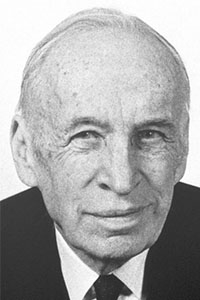John Hasbrouck Van Vleck
John Hasbrouck Van Vleck (1899-1980), cowinner of the 1977 Nobel prize in physics, served as the first "modern" Dean of Engineering and Applied Physics at Harvard from 1951-57.
Born in Middletown, Connecticut, Van Vleck grew up in Wisconsin and earned his bachelor's degree from the University of Wisconsin in 1920. He earned his master's degree at Harvard University in 1921 and a doctorate in 1922 also at Harvard.
Van Vleck taught at Harvard for one year before moving on to the University of Minnesota in 1923. After five years there, he taught at the University of Wisconsin, returning to Harvard in 1934 as an associate professor for math and physics.
In 1935, Van Vleck was named a full professor and ten years later, chairman of the school's physics department. In 1951, he was named the Hollis professor of Mathematics and Natural Philosophy. He retired from teaching in 1969.
The research conducted by Van Vleck through 50 years, and especially his work in the 1930s, is credited with creating the modern theory of magnetism.
Father of Magnetism
The Swedish Academy of Sciences called Van Vleck the "father of modern magnetism" when he was named along with one of his former students and an English professor as corecipient of the Nobel prize.
Van Vleck and his cowinners - Philip Anderson, a former student of Van Vleck's, and Sir Nevill Mott - were cited for research on the electronic structure of magnetic and "disordered systems" - work that has been applied to the development of the laser, new industrial uses of glass and copper spirals used in birth control devices.
The so-called "disordered systems" exists within noncrystallic materials that have irregular atomic structures, making it difficult to theorize about them.
Van Vleck was the first to indicate the importance of electron correlation - the interaction between the motions of the electrons.
The author of numerous articles and monographs on physics, Van Vleck's 1932 book, Electric and Magnetic Susceptiblities, has remained of central importance in the field of theoretical physics.
Getting to the Truths of Things
Van Vleck once described his research as an attempt to "get at what is the truth of things. The more we know about the universe, the better off we are."
After learning he had been selected as a Nobel winner, he told reporters, "So often the prizes go to younger men. Anybody couldn't help feeling that it is a culmination when you're 78 years old."
Among other awards presented Van Vleck were a decorated chevalier Legion of Honor from the French government in 1963 and the National Medal of Science in 1966.
He was a member of numerous professional organizations both in the United States and abroad, including the American Philosophical Society, the Royal Society of London, the French Academy of Science and the Royal Academies of Sweden and The Netherlands.
(Content adapted from the Nobel Foundation.)
